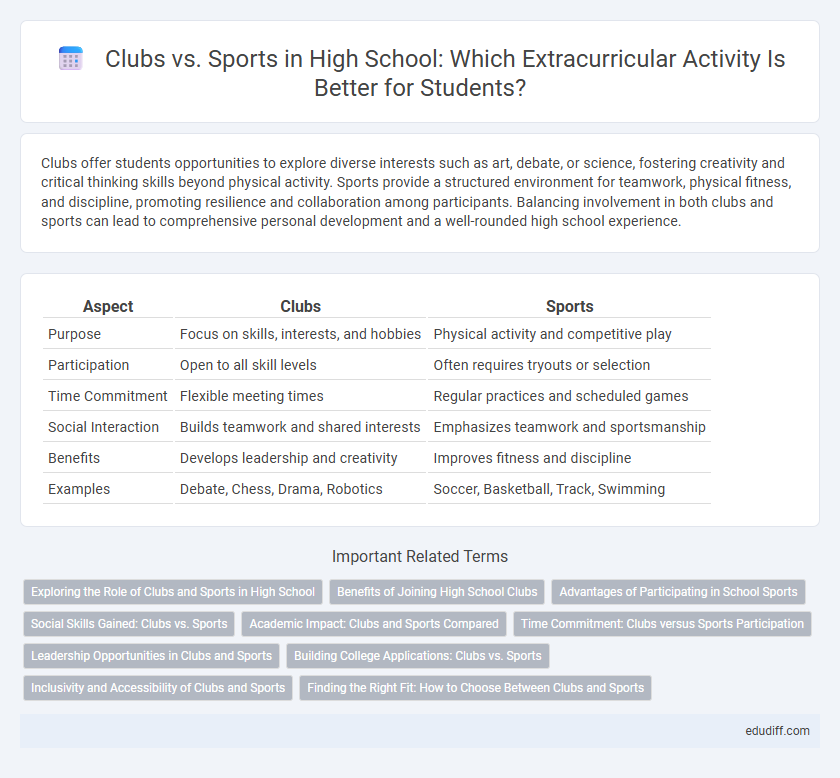Clubs offer students opportunities to explore diverse interests such as art, debate, or science, fostering creativity and critical thinking skills beyond physical activity. Sports provide a structured environment for teamwork, physical fitness, and discipline, promoting resilience and collaboration among participants. Balancing involvement in both clubs and sports can lead to comprehensive personal development and a well-rounded high school experience.
Table of Comparison
| Aspect | Clubs | Sports |
|---|---|---|
| Purpose | Focus on skills, interests, and hobbies | Physical activity and competitive play |
| Participation | Open to all skill levels | Often requires tryouts or selection |
| Time Commitment | Flexible meeting times | Regular practices and scheduled games |
| Social Interaction | Builds teamwork and shared interests | Emphasizes teamwork and sportsmanship |
| Benefits | Develops leadership and creativity | Improves fitness and discipline |
| Examples | Debate, Chess, Drama, Robotics | Soccer, Basketball, Track, Swimming |
Exploring the Role of Clubs and Sports in High School
High school clubs and sports both play essential roles in student development by fostering teamwork, leadership, and social skills. Sports offer physical activity and competition, promoting health and discipline, while clubs provide diverse opportunities for creativity, intellectual growth, and community service. Balancing participation in both enriches the high school experience by supporting well-rounded personal and academic growth.
Benefits of Joining High School Clubs
Joining high school clubs enhances social skills and fosters a sense of community among students, promoting teamwork and leadership in diverse interest areas. Clubs offer creative and academic enrichment opportunities, supporting personal growth beyond athletic abilities found in sports. Participation in clubs also improves college applications by demonstrating commitment and a range of extracurricular interests valued by admissions committees.
Advantages of Participating in School Sports
Participating in school sports enhances physical fitness, promotes teamwork skills, and fosters discipline among high school students. Involvement in sports often leads to improved time management and academic performance due to structured schedules and goal-setting. Furthermore, school sports create opportunities for social interaction and leadership development, contributing to overall personal growth.
Social Skills Gained: Clubs vs. Sports
Participation in high school clubs fosters diverse social skills through collaboration, communication, and leadership in varied interests such as debate, drama, or coding. Sports involvement enhances teamwork, discipline, and conflict resolution while promoting physical health and competitive spirit in environments like soccer, basketball, or track. Both settings cultivate interpersonal abilities but differ in emphasis, with clubs encouraging creativity and niche networking, whereas sports focus on physical coordination and collective goal achievement.
Academic Impact: Clubs and Sports Compared
Participation in high school clubs is often linked to improved academic performance due to enhanced skills in time management, collaboration, and critical thinking. Sports involvement also contributes positively to academics by fostering discipline, focus, and physical well-being, which support cognitive function and concentration. While both clubs and sports offer unique benefits, research suggests that clubs may provide more direct opportunities for academic enrichment through specialized activities and intellectual challenges.
Time Commitment: Clubs versus Sports Participation
Sports participation requires a significant time commitment with regular practices, games, and travel often demanding daily involvement during the season. Clubs typically offer more flexible schedules, meeting weekly or biweekly, accommodating students with varied academic and extracurricular workloads. Balancing sports and clubs effectively enables students to develop time management skills and pursue diverse interests.
Leadership Opportunities in Clubs and Sports
Clubs in high school provide diverse leadership roles such as president, secretary, and event coordinator, fostering organizational and collaborative skills. Sports teams offer captaincy and coaching assistant positions that enhance leadership through teamwork, motivation, and strategic planning. Both clubs and sports develop critical leadership qualities essential for college applications and future career success.
Building College Applications: Clubs vs. Sports
Participation in high school clubs enhances college applications by showcasing leadership, commitment, and specialized interests, which demonstrate a well-rounded profile. Sports involvement highlights teamwork, discipline, and physical endurance, traits highly valued by admission committees. Balancing both clubs and sports creates a diverse extracurricular portfolio, increasing appeal to colleges seeking multifaceted students.
Inclusivity and Accessibility of Clubs and Sports
High school clubs often provide greater inclusivity and accessibility compared to sports by accommodating diverse interests, skill levels, and schedules, allowing more students to participate regardless of physical ability. Clubs typically require fewer resources and less specialized equipment, lowering barriers to entry and fostering a welcoming environment for all backgrounds. Sports programs can be more competitive and physically demanding, which may limit participation, whereas clubs prioritize creativity, collaboration, and community engagement.
Finding the Right Fit: How to Choose Between Clubs and Sports
Selecting between clubs and sports in high school depends on personal interests, time commitment, and social goals. Sports often demand rigorous physical activity and regular practice, appealing to those seeking teamwork and athletic competition. Clubs provide diverse opportunities for skill development and creativity, ideal for students focused on hobbies or academic enrichment.
Clubs vs Sports Infographic

 edudiff.com
edudiff.com